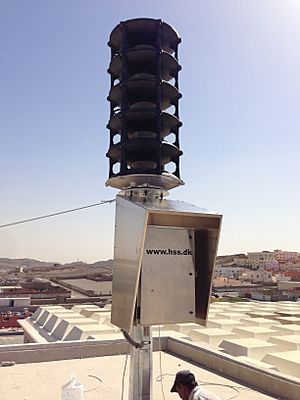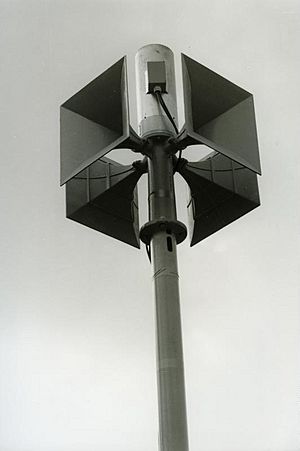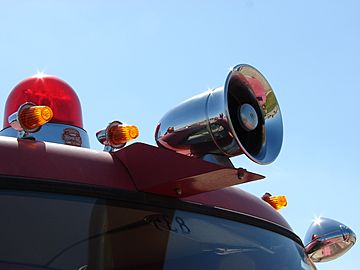Siren (alarm) facts for kids
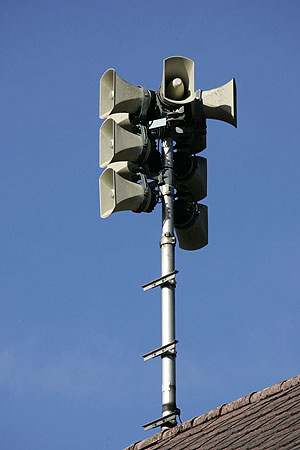
A siren is a device that makes a very loud noise. Sirens are used to warn people about danger or to get attention. You often hear them on emergency service vehicles like ambulances, police cars, and fire engines.
Some sirens, called Civil defense sirens, are placed in fixed spots. They warn communities about natural disasters like tornadoes or other dangers. Many fire sirens also act as civil defense sirens. They are usually on fire station roofs or tall structures like water towers.
Fire sirens are sometimes called "fire whistles" or "fire horns." They can make different sounds to signal different things. For example, some can make a "hi-lo" sound for a fire or a "wail" for a general alert. Many fire sirens are tested once a day, often at noon, which is why they are sometimes called "noon sirens."
Long ago, emergency vehicles used bells to make noise. In the 1970s, they switched to two-tone air horns. By the 1980s, electronic wailing sounds became common.
Contents
History of Sirens
The first siren was invented by a Scottish scientist named John Robison before 1799. He used his sirens as musical instruments, helping to power organ pipes. His siren worked by opening and closing a tube that let air through.
In 1819, Baron Charles Cagniard de la Tour made a better siren and gave it the name "siren." His design used two disks with holes. One disk stayed still, and the other spun. As the spinning disk blocked and unblocked the air, it created a sound. De la Tour's siren could even make sounds underwater, which reminded him of the sirens from Greek myths. This is how the device got its name.
Most modern mechanical sirens use two cylinders instead of disks. The inner cylinder spins, and the outer one stays still. Both cylinders have slots. When air flows through these slots, it is regularly interrupted, making a sound. The first sirens like this were made in the late 1800s. Later, electric motors powered these sirens, using a fan to create the airflow.
Sirens often have a horn attached. This horn helps direct the sound and makes it louder by changing the high-pressure sound waves into lower-pressure waves that travel well in the open air.
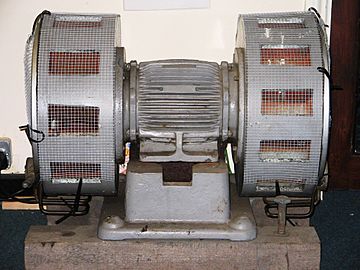
At first, volunteer firefighters were called by ringing a bell at the fire station or a local church. When electricity became common, the first electric fire sirens were made around 1900. Two early companies were Decot and Sterling Siren. Today, many communities no longer use fire sirens because firefighters often carry pagers that alert them directly.
During the Second World War, the British civil defense used many sirens. These sirens warned people about air raids (enemy planes attacking). A single steady tone meant "all clear," while a series of tones meant an air raid was happening.
Types of Sirens
Pneumatic Sirens
A pneumatic siren works by using a spinning disk with holes, called a rotor or chopper. This rotor spins past fixed holes on the outside of the siren, called a stator. As the holes line up and then get blocked, air flows and stops, creating sound waves. These sirens can use a lot of energy. Some designs use compressed air from a tank to make them louder without using as much power.
In the United States, vehicle pneumatic sirens are sometimes called mechanical or coaster sirens. This helps tell them apart from electronic sirens. Mechanical sirens powered by an electric motor are often called "electromechanical." One famous example is the Q2B siren. It is very loud (123 dB at 10 feet) and effective, but it uses a lot of electricity. Because of this, it is mostly used on fire trucks and large rescue vehicles.
In Germany and some other European countries, pneumatic two-tone (hi-lo) sirens use two sets of air horns, one high-pitched and one low-pitched. An air compressor blows air into one set, then switches to the other. This back-and-forth switching creates the changing tone. These sirens can also be very loud, around 125 dB. They use less electricity than mechanical sirens but need more care.
In a pneumatic siren, the stator is the part that cuts off and reopens the air as the rotor's blades spin past its holes, making the sound. The sound's pitch depends on how fast the rotor spins and how many holes are in the stator. A siren with only one row of holes makes a single tone. A siren with two rows of holes makes a dual tone.
By adding a second stator that can open and close all the holes, a siren can create a "pulse" tone. If this happens while the siren is wailing, it's called a "pulse wail." On a dual-tone siren, opening and closing each row of holes separately can create a "Hi/Lo" tone. If this is done while the siren is wailing, it's a "Hi/Lo wail." Some sirens can even send Morse code by opening and closing the holes. These are called "code sirens."
Electronic Sirens
Electronic sirens use special electronic parts like oscillators and amplifiers to create different siren sounds. These sounds include wail, yelp, hi-lo, and airhorn. The sounds are then played through external speakers. It's common for modern fire trucks to have both mechanical and electronic sirens. Police sirens often use a musical interval called a tritone to grab attention. The first electronic siren that sounded like a mechanical one was invented in 1965 by Motorola employees.
Other Warning Devices
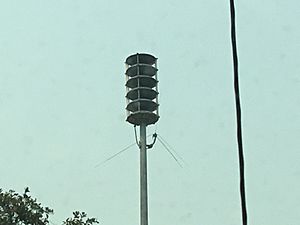
Steam whistles were also used as warning devices, especially where steam was available, like at sawmills or factories. These were common before electric fire sirens. Large compressed air horns, called fire horns, were also used. Many fire horn systems were connected to fire alarm boxes around a town. When a box was pulled, the horn would "blast out" a code telling firefighters where the fire was. For example, box 233 might make the horn sound two blasts, then a pause, then three blasts, then a pause, then three more blasts. This was the only way to know a fire's location before telephones were common.
How Sirens Make Sound
Mechanical sirens make sound by blowing air through a spinning disk or rotor with slots. The air pressure changes in cycles, creating sound waves. In many sirens, a fan and rotor are combined into one part that spins with an electric motor.
Electronic sirens are basically very efficient loudspeakers with special amplifiers and sound generators. They usually copy the sounds of mechanical sirens so people recognize them.
Sirens often use a relatively low frequency sound, usually a few hundred hertz. Lower frequency sounds can travel around corners and through obstacles better.
Horns are used with sirens to aim the sound waves. This makes the siren's energy more effective by directing the sound where it's needed.
The frequency (how many cycles per second) of a mechanical siren's sound is controlled by how fast its rotor spins and how many openings it has. The "wailing" sound of a mechanical siren happens as the rotor speeds up and slows down. Wailing usually means an urgent emergency.
The unique sound of a mechanical siren is because its sound wave looks like a triangle when graphed. As the openings widen, the sound pressure increases, and as they close, it decreases. This gives the sound special musical qualities. Distant sirens often sound "softer" because the harsh, high-pitched sounds are absorbed by objects nearby.
Two-tone sirens often make a "minor third" musical interval, which can sound a bit sad. To do this, they have two rotors with different numbers of openings. The higher tone's rotor has a number of openings that can be divided by six, and the lower tone's rotor has a number that can be divided by five. Electronic sirens can easily make a perfectly tuned minor third.
A mechanical siren that can switch between its two tones uses special parts called solenoids. These move shutters that block the air supply to one rotor, then the other. This is often used to signal a fire warning.
When sirens are tested, they usually don't make a scary sound. Electronic sirens might play musical tunes like Westminster chimes. Mechanical sirens sometimes "growl" by operating at low speeds for testing.
Vehicle-Mounted Sirens
Rules and Approvals
Governments often have rules for sirens on vehicles. For example, in California, sirens are either Class A or Class B. A Class A siren is loud enough to be placed almost anywhere on a vehicle. Class B sirens are not as loud and must be placed in specific ways, usually parallel to the road and the direction the vehicle travels.
Sirens also need to be approved by local agencies. For example, the California Highway Patrol approves specific siren models for emergency vehicles in the state. This approval ensures the sirens work correctly. Using unapproved devices could even affect who is at fault if a collision happens.
The SAE International committee helps set standards for emergency vehicle lights and sirens. Their J1849 standard helps ensure sirens meet certain sound output levels.
Best Ways to Install Sirens
Siren speakers or mechanical sirens should always be placed in front of the passenger area of a vehicle. This makes the siren quieter inside the vehicle, so occupants can hear two-way radios and phone calls better. It also puts the sound where it is most useful. A study in 2007 found that sound levels inside the passenger area could be very high, over 90 dB(A).
Research shows that placing sirens behind the engine grille or under the wheel arches can reduce unwanted noise inside the vehicle and to the sides and rear. At the same time, it keeps the warning sound loud enough in front. Adding "broadband sound" (a wide range of frequencies) to sirens can help people figure out where the sound is coming from. This is because the brain uses different clues from various frequencies to locate a sound.
The worst places to install sirens are above and slightly behind the vehicle occupants, such as speakers mounted on a light bar on a car or pickup truck. Vehicles with hidden sirens also tend to have high noise levels inside. In some cases, poorly installed or hidden sirens can make noise levels so high that they can permanently damage the hearing of people inside the vehicle.
Electric-motor-driven mechanical sirens can use a lot of electricity (50 to 200 amperes at 12 volts DC) when they are speeding up. So, proper wiring and protection for the vehicle's computer systems are very important. The wiring should be as thick as the wiring to the engine's starter motor. Mechanical vehicle sirens usually have an electric brake. This is a part that presses a pad against the siren's spinning rotor. This allows the operator to quickly stop the siren when the emergency vehicle arrives at its destination or is no longer needed.
Multi-speaker electronic sirens sometimes have "dead spots" where the sound is quieter at certain angles to the vehicle. This happens because sound waves from different speakers can cancel each other out at specific frequencies. However, sirens are designed to sweep through a range of frequencies. This sweeping helps to reduce the effects of sound cancellation. As a result, a dual-speaker siren system is usually about 3 dB louder than a single-speaker system.
Sirens in Music
Sirens are also used as musical instruments. They have been used in works by modern classical composers like Edgard Varèse and Dimitri Shostakovich. For example, Varèse used sirens in his pieces Amériques and Ionisation.
In popular music, sirens have appeared in songs like "Song to the Siren" by The Chemical Brothers. The opening notes of the REO Speedwagon song "Ridin' the Storm Out" are a siren sound played on a keyboard. Some heavy metal bands even use air raid siren sounds at the start of their concerts. The Canadian band Sloan used multiple overlapping sirens in the opening of their 1998 song "Money City Maniacs."
See also
 In Spanish: Sirena (instrumento acústico) para niños
In Spanish: Sirena (instrumento acústico) para niños
- Blues and twos
- Chrysler air raid siren
- Civil defense siren
- Foghorn
- Klaxon
- Thunderbolt siren
- Warning system



